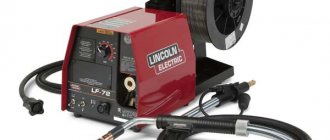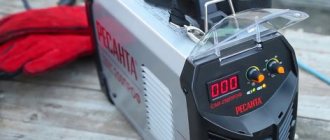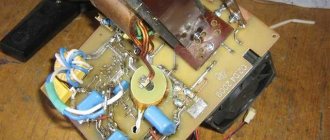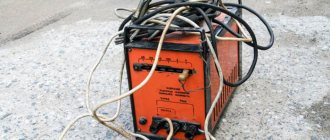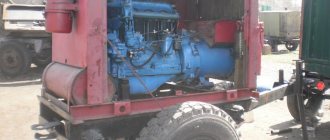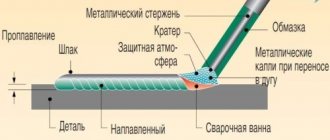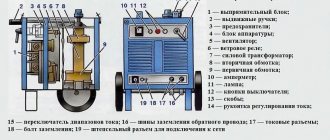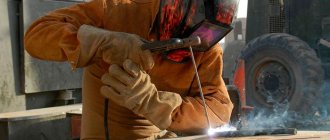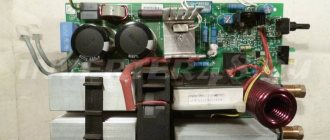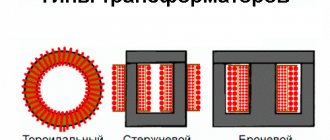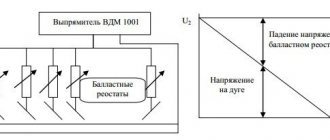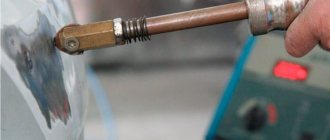Home / Devices
Back
Reading time: 3 min
0
2107
What should you pay attention to when choosing welding equipment? As a rule, when buying a welding unit for the home, they take into account the power, size, additional settings, and also the price tag.
Speaking about industrial units, the voltage of the electrical network they request plays a big role here.
Residential buildings are supplied with 220V voltage as standard. But providing constant 380V power in factories is a completely solvable task. Therefore, three-phase devices can be easily installed and used in workshops.
This article will discuss the industrial welding machines themselves, their varieties and parts that you should know about when choosing.
- General information
- Variations Transformer
- Rectifier
- Inverter and semi-automatic
Basic recommendations and safety precautions
Before you are going to connect the welding machine, be sure to make sure that the frequency and voltage indicated on the equipment case match that of the network. Connecting such equipment requires making the correct connections. For this, the following wires are used: a phase or 2 phases in combination with a neutral and a grounding wire, which is usually green or yellow.
Electrode position during welding.
If the welding machine model you have chosen allows you to set the voltage yourself, you should fix the switch in a position that would correspond to the voltage in your network. The position is fixed using a locking screw.
A plug is used to connect the welding machine. It is very important that it meets established thermal throughput standards. This plug must have a grounding lug. It is to this that the corresponding cable will be connected. This plug cannot be plugged into a regular household outlet. A fused socket is suitable for connection. An auto switch is also suitable.
You will need to connect the return ground cable to the appropriate terminal. You need to connect at the shortest possible distance from the future seam. A specially designed clamp is used to attach the cable holder to the protruding fragment of the electrode.
Before connecting the welding unit directly to the network, be sure to check how securely the plugs are secured.
Due to poor contact, the device will not work at full capacity and will quickly fail.
Figure 1. Connection diagram of the welding machine: 1-welding station; 2—three-core hose cable; 3 - transformer; 4-regulator; 5-grounding clamps of the unit body; 6 - single-core hose cable; 7-electric holder; 8 - ground wires.
There are quite a lot of schemes according to which the welding unit is connected. The most common connection diagram is shown in Fig. 1.
- Position 1 is a welding station;
- number 2 indicates a three-core hose cable;
- 3 - transformer;
- 4th position - regulator;
- number 5 - grounding clamps of the unit body;
- 6 - single-core hose cable;
- 7th position - electric holder;
- number 8 - ground wires.
Remember and follow all these rules when connecting the welding machine to avoid injuries and other unpleasant consequences. Failure to comply with the safety system of the welding machine may result in fire or electric shock. If any of the power cables break, they must be replaced immediately. It is best to entrust this work to professionals. Any repair and maintenance work can be performed only after the welding machine is disconnected from the network.
When connecting the welding machine, be sure to check the quality of the permanently laid and flexible wires. Check their grounding, continuity and insulation to ensure compliance with established standards. Don't skimp too much on grounding. It is best to use flexible copper wire for it. If twists, cracks or other defects are detected, the wire must be replaced. The use of damaged wires leads to overheating and may cause damage to the welding machine. An important fact is the need to unwind the wires. If this requirement is neglected, inductance will occur and resistance will decrease.
The voltage for welding machines is not standardized, so pay attention to the characteristics of the particular model you will be working with. When assembling such equipment, it is given a certain voltage level. The resistance value is not taken into account.
This is interesting: Do-it-yourself semi-automatic welding machine: diagram and assembly steps
Variations
Transformers, rectifiers, inverters and semi-automatic machines are all types of three-phase welding devices.
We will introduce you to each of them.
Transformer
The transformer (380V) is classified as a type of classic industrial welding equipment. This device received the name three-phase because of the three coils at its base.
Receiving three phases, which in turn ensures stable arc burning and voltage during the welding process. The simple design of the unit is easy to repair, and not expensive.
It must be taken into account that the transformer produces only alternating current. For this reason, you will not be able to use direct current in your work.
A trolley is used to transport the transformer; it is heavy and of impressive size. At the same time, it has a good price tag.
Step-by-step instructions for connecting a welding machine
Figure 2. Sequence diagram for connecting the welding machine.
After you have checked the integrity of the unit and all related components, and also established the voltage compliance, you can proceed directly to connecting your welding machine. For this you will need:
- the unit itself;
- extension;
- adapter for extension cord.
When connecting the device, you can refer to the diagram in Fig. 2.
The connection is made in a certain sequence, namely:
- First, a plug is prepared with the appropriate thermal throughput parameters.
- Select a socket with a circuit breaker or fuse.
- The return cable is connected to the terminal.
- The holder cable is connected to the electrode fragment using a clamp.
After you have done all this, the welding machine can be connected to the network. Most models have fairly short wires, so connecting them often requires the use of an extension cord. The extension cord must have a wire of sufficient cross-section. The reliability and safety of operation depends on the number of intermediate connections. The fewer there are, the better.
Industrial MIG/MAG welding machines | buy in Moscow with delivery throughout Russia
Nutrition:
220V
Welding current:
20-185A
Synergic:
stainless steel, steel, aluminum, copper soldering.
Pulse mode in the basic version!
Certified for car manufacturers. Country of origin: Italy. 24 month warranty.
Cebora EVO SPEED STAR 520 TS PROMOTION! Pulse and Double Pulse functions as a gift! Industrial semi-automatic Power supply:
380V
Welding current:
10-520A
Synergic:
stainless steel, aluminum, steel.
Pulse, Double Pulse
Country of origin: Italy. 24 month warranty.
Cebora Synstar 270T SRS Edition Industrial welding machine
MIG/MAG, TIG DC, MMA
Power:
380V
Welding current:
10-270A
Synergic:
stainless steel, aluminum, copper, steel.
Full functionality already in the basic version: Pulse, Double Pulse, SRS (coolArc), TIG DC.
Country of origin: Italy. 24 month warranty.
Nutrition:
220V
Welding current:
20-200A
Synergic:
stainless steel, aluminum, steel, copper and galvanized soldering.
Certified for car manufacturers
Country of origin: Italy.
24 month warranty. Power:
380V
Welding current:
20-200A
Synergic:
stainless steel, aluminum, steel, copper and galvanized soldering.
Certified for car manufacturers
Country of origin: Italy.
24 month warranty. Power:
220V
Welding current:
20-250A
Synergic:
stainless steel, aluminum, steel, copper and galvanized soldering.
Certified for car manufacturers
Country of origin: Italy. 24 month warranty.
Nutrition
: 380V
Welding current
: 20-270A
Synergic
: stainless steel, aluminum, copper, steel.
Pulse mode.
Country of origin: Italy.
24 month warranty. Industrial welding machine
MIG/MAG, TIG DC, MMA
Power:
380V
Welding current:
15-330A
Synergic:
stainless steel, aluminum, copper, steel.
Pulse, Double Pulse in the database!
Country of origin: Italy.
24 month warranty. Industrial welding machine
MIG/MAG, TIG DC, MMA
Power
: 380V
Welding current
: 15-330A
Synergic:
stainless steel, aluminum, copper, steel.
Pulse, Double Pulse in the database!
Country of origin: Italy. 24 month warranty.
Industrial welding machine
MIG/MAG, TIG DC, MMA
Power:
380V
Welding current:
10-400A
Synergic:
stainless steel, aluminum, copper, steel.
Pulse, Pulse HD, Double Pulse, Doble Pulse HD, SRS (coolArc), WEB control, FULL TIG (TIG XP, APC,EVO START)
Country of origin: Italy. 24 month warranty.
Industrial welding machine
MIG/MAG, TIG DC, MMA
Power:
380V
Welding current:
10-520A
Synergic:
stainless steel, aluminum, copper, steel, powder.
Pulse, Pulse HD, Double Pulse, Doble Pulse HD, SRS (coolArc), WEB control, FULL TIG (TIG XP, APC,EVO START)
Country of origin: Italy. 24 month warranty.
Cebora Synstar TWIN 270 T Power
: 380V
Welding current
: 20-270A
2 spools with Synergic
: stainless steel, aluminum, steel.
Certified for VAG (Volkswagen).
Country of origin: Italy. 24 month warranty. Cebora Sound MIG 2060/MD Star Double Pulse
Nutrition:
2200V
Welding current:
15-200A
Synergic:
stainless steel, aluminum, copper, steel.
Pulse, Double Pulse OEM certified;
Country of origin: Italy. 24 month warranty.
Cebora EVO 350 TC Synergic Power:
380V
Welding current:
35-400A
Synergic:
stainless steel, aluminum, copper, steel.
Country of origin: Italy. 24 month warranty. Cebora EVO 350 TS Synergic Industrial semi-automatic Power:
380V
Welding current:
35-400A
Synergic:
stainless steel, aluminum, steel.
Country of origin: Italy. 24 month warranty. Cebora EVO 450 TS Synergic Industrial semi-automatic Power supply:
380V
Welding current:
40-500A
Synergic:
stainless steel, aluminum, steel.
Country of origin: Italy. 24 month warranty. Power:
220V
Welding current:
20-200A
Synergic:
stainless steel, aluminum, steel.
Country of origin: Italy. 24 month warranty. Are you looking for modern, reliable, and most importantly high-quality welding equipment? The Italian company Cebora, which produces welding machines using advanced welding technology and supplies its products to 120 countries around the world, !
"Cebora - Russia" offers to buy professional and industrial semi-automatic welding MIG-MAG with synergetic control, optimizing welding processes of various metals: steel, stainless steel, aluminum, copper and various alloys. In particular, they significantly simplify the welder’s work and improve the quality of welds. Welding work is performed faster and with better quality than with conventional machines with manual settings. The welder does not waste time selecting parameters, because the synergic control does this independently. The experience accumulated by Cebora over more than 65 years of operation allows it to be one of the world leaders in the field of electric welding. Today, Italian Cebora welding machines are well known in Europe and other regions, including Russia, where they have proven themselves to be the best. The use of the most effective synergistic technologies, the widespread introduction of innovations and strict product quality control - all this, combined with its very reasonable cost (compared to competitors), have become powerful arguments in favor of purchasing Cebora equipment. In addition, our industrial welding machines and semi-automatic machines have high technical and operational characteristics, but at the same time they are very easy to operate. Each semi-automatic welding machine from Cebora has a set of synergetic programs for almost perfect welding of stainless steel, aluminum and its alloys. Setting is carried out only by selecting the wire and the thickness of the workpiece being welded. The device selects the remaining parameters independently! Need quality seams? Then buy Cebora and we will not disappoint you!
MIG/MAG welding equipment is divided into 2 types: inverter semi-automatic welding machines with synergetic technology and transformer machines also with synergic control.
Each Cebora welding machine, be it the professional Pocket Pulse, Synstar 200/270/330 or the industrial KING STAR 400/520, does an excellent job of welding stainless steel, black steel and aluminum.
Buying welding machines in Moscow from Cebora means providing your enterprise with reliable and modern welding equipment for many years.
The main advantages of CEBORA welding equipment
Having purchased a mig-mag semi-automatic welding machine from a European manufacturer, you will appreciate its manufacturability. Unique functionality and welding technologies, as well as performance characteristics:
- Cost:
the price of Cebora inverter-type welding machines compares favorably in cost with other brands. - Reference quality welding of aluminum and stainless steel.
You can buy semi-automatic welding machines for stainless steel and aluminum, specially adapted for these types of materials, which allows you to obtain standard quality seams, in Moscow and the regions of Russia. Other, more specific types of devices are also available. For example, it will not be a problem to find and buy from us a welding machine for welding aluminum with two spools and wire feed mechanisms, ideal for the high standards of modern car service, as well as the consumables, welding torches, tools and accessories necessary for their operation.
- Synergetic technologies.
All semi-automatic welding machines have advanced MIG-MAG welding technology using synergetic programs. Settings take place in 2-3 clicks on the display or joystick. The digital intelligence of each model contains programs for welding stainless steel, steel, aluminum, as well as for soldering copper and various alloys. - Advanced welding technologies.
The new line of multifunctional MIG-TIG-MMA welding machines CEBORA King Star series has the most advanced technologies for welding various metals. For example, the Pulse HD and Double Pulse functions can significantly improve the quality of seams. Buy a semi-automatic welding machine and you can quickly adjust the process to the characteristics of the material and production. For example, minimize splashing thanks to SRS technology. - WEB interface and remote management:
the new hardware architecture allows the implementation of a web server, which, through LAN and Wi-Fi connections in addition to two USB ports, provides useful functions for remote maintenance, information system diagnostics, backup and recovery data, firmware updates and etc. and for all those activities that require data collection and processing. - Convenient delivery method throughout Russia
. You can buy a semi-automatic welding machine or a multifunctional welding machine both from us at Chebora-Trading LLC and from our regional dealers in Moscow, St. Petersburg, Nizhny Novgorod and other cities of Russia. Most devices are in stock. Delivery and commissioning is carried out up to 10 days. - Professional consultation.
When ordering a professional and industrial series of welding machines, our company’s specialists will provide advice and help with choosing a specific model based on the customer’s requirements. By purchasing welding equipment from us, you are guaranteed high professionalism, prompt service and an individual approach to each customer, without exception. - Long warranty.
All Cebora welding equipment is provided with a factory warranty of 24 months (2 years). An on-site warranty service is available. Therefore, having purchased industrial and powerful welding machines, you can be sure that any possible problems with them will be resolved as quickly as possible.
Where to buy professional and industrial Cebora welding machines?
You can buy semi-automatic welding machines manufactured by CEBORA from the official representative of Chebora-Trading LLC in Moscow, Moscow region, Rostov-on-Don.
And also from our regional dealers in Moscow, Moscow region, St. Petersburg, Vladimir, Voronezh, Nizhny Novgorod, Rostov-on-Don, Volgograd, Yekaterinburg, Kazan, Komsomolsk-on-Amur, Krasnodar, Krasnoyarsk, Norilsk, Novosibirsk, Perm, Ryazan, Simferopol, Smolensk, Tver, Tula, Ufa, Yakutsk, Yaroslavl and other cities of Russia.
Types of three-phase devices
Three-phase welding machines come in three types:
- transformer;
- rectifying;
- inverter
Welding equipment of the first type is based on a three-phase transformer. The primary winding consists of three windings connected in a star, and the secondary step-down winding is connected in a delta.
If alternating current is used for welding, then a reduced voltage is supplied from each phase of the secondary winding via a separate wire to the electrode through an inductor. Compared to a single-phase welding transformer, the welding is softer, the electric arc becomes more stable, and the voltage drop is less.
The rectifiers at the output of the secondary winding have three half-bridge circuits assembled from powerful diodes. As in the first case, current is supplied from each rectifier to the welding electrode.
Compared to a rectifier in one phase, pulsations are significantly less; accordingly, the welding current is more stable, which affects the quality of welding.
In three-phase inverters with the same welding power, you can use less powerful diodes and transistors, but this is practically not done. On the contrary, the use of three-phase voltage makes it possible to obtain high-power devices with small dimensions and weight.
Varieties
Industrial three-phase devices come in three types: transformers, rectifiers, inverters and semi-automatic devices. Let's take a closer look at each of them.
Transformer
A 380 volt transformer is the simplest and classic type of welding equipment. Its basis is a transformer with three coils. Hence the name of this welding machine. Thanks to the use of three phases, the arc burns stably and the voltage practically does not change during welding. And the design of these machines is so simple that it allows you to repair the transformer literally “on the knee”, and without extra costs.
Transformers only supply alternating current, so you cannot use direct current in your work. This needs to be taken into account. Transformers are very bulky and heavy and require a cart to move them. But the price of such devices will please any professional.
Rectifier
A rectifier is the same transformer, only with one significant difference. A rectifier unit is built into its body (hence the name “rectifier”), which converts alternating current into direct current. This is their only difference. Such devices are more versatile than transformers, since they allow you to cook on any type of current.
Also, thanks to the rectifier, the arc burns more stable and is easier to ignite, including re-ignition. If you are a beginner, you have probably encountered difficulties in igniting the arc when using a transformer. The rectifier unit slightly, but simplifies this task. Otherwise, there are no differences between a rectifier and a transformer.
Inverter and semi-automatic
Semi-automatic welding and inverter are devices of a new generation. They are complex in design, have built-in microcircuits and additional functions. Their weight and dimensions are significantly smaller than those of a transformer or rectifier. But all the advantages come at a price. An inverter and semi-automatic device are significantly more expensive than other types of industrial devices.
The difference between an inverter and a semiautomatic device lies in the scope of application. The inverter's path is manual arc welding with electrodes. But the semi-automatic machine is used when welding using gas and filler wire. The semi-automatic machine has a filler material supply mechanism, which often operates in semi-automatic mode. Hence the name.
Possible problems after connection
Figure 4. Connection diagram for welding transformer.
After connecting the welding machine, various problems may arise, for which you need to be prepared and know how to get rid of them. If there is strong heating of the windings and humming, then the reason lies in a turn short circuit in the primary windings. In this case, you will have to completely or partially rewind the windings.
Welding transformers may produce too much current due to a short circuit in the regulator winding or in the secondary winding. To eliminate the malfunction, you need to eliminate the short circuit in the windings or rewind.
If, when exposed to the regulator, the welding current does not decrease, then the reason, as a rule, is a short circuit between the terminals of the regulator.
While working with the device, you may hear an uncharacteristic hum. It usually appears due to weakening of the spring tension or due to a broken wire.
The cause of excessively hot contacts in connections is usually faulty electrical contact. You can get rid of this malfunction by rebuilding overheating connections. The contact surfaces are cleaned and fit tightly. The clamps are tightened until they fail. Good luck!
Wiring and socket requirements
Table of required technical characteristics for a welding machine
According to the principle of operation, a welding machine is a current converter into a welding arc. The operating current range (equipment power) is the main characteristic of the device, which determines its technical parameters. It must be consistent with the building's electrical capabilities. To determine this, the network voltage is multiplied by the maximum permissible current value (indicated on the input panel). Compare the obtained value with the data in the equipment data sheet.
From a 220 V household outlet, you can only power an inverter device, which is a more advanced device with many settings and safety parameters. In this case, it must have a built-in refractory fuse or circuit breaker. In old houses, the wiring is designed for a maximum current of 10 A, and when the device is started, there is a jump to 40 A - in such buildings you need to connect to the panel.
A transformer device, which is designed to operate from 380 V, is connected only through the electrical panel. If the wiring is weak, it is recommended to use a gas generator.
This is interesting: Do-it-yourself spotter from a welding machine - how to make it
Comparison of household and professional models
The main difference between professional and household equipment is the scope of application, which is determined by the power of the devices and the maximum volume of work performed without interruption. Household devices are used for welding pipes, angles and other types of rolled products in the country, in the garage, in private low-rise houses and farms. Welding machines for home use are characterized by a short-term operating mode. They are designed to perform small volumes of work and require long breaks after use for 5-10 minutes.
Prof. welding machines are in demand in the following cases:
- during installation and repair of communications at housing and communal services facilities;
- for repairing pipe damage and carrying out welding work in the energy industry;
- for installation of metal structures during the construction of industrial and administrative buildings and structures.
Depending on the type and model of a professional welding machine, the duration of its activation can be up to 100%, and the same parameter for household devices is much lower. The duration of work without interruption and the duty cycle indicator are indicated by the manufacturers in the equipment passport. It should be taken into account that the duration of switching on will depend on the ambient temperature.
Other parameters in which professional welding equipment differs from household units include:
- Welding current. It is indicated in the passport and represents a standard at which the operation of the welding machine is carried out in normal mode, without overheating and overload. For household models, 120-200 A is sufficient, and for professional devices this figure should be at least 200-300 A. When purchasing equipment, it is advisable to give preference to devices that have, in addition to the operating current indicators, up to 30-50% reserve. This will avoid overheating of the welding inverter and prevent its failure.
- Type of food. Household devices are designed to be connected to a stable or unstable network with a voltage of 220 V.
Professional models have a more varied choice. Depending on the technical parameters of the welding equipment, the energy source can be:
- stationary or autonomous network 220 V;
- stationary three-phase network 380 V;
- autonomous power supply from a 380 V electric generator.
Most professional units operate when connected to a three-phase network with a voltage of 380 Volts.
A comparison of the main parameters of household and professional equipment shows significant differences in the technical capabilities of the units. It is impractical and economically unprofitable to use powerful devices for rare welding work in a garage or country house.
Popular models
The 380 V semi-automatic welding inverter is the most common device among professional devices. Unlike transformer devices, they have small dimensions and weight.
The Czech-made TESLA MIG 350 semi-automatic welding machine has proven itself when working in difficult conditions. In case of unstable or reduced supply voltage, it provides a stable welding arc, operates at a voltage of 380 V, and the maximum welding current is 350 A.
The welding wire feeding mechanism of the device has two rollers, the power consumption is 11.9 kW. The power reserve allows the use of long cables up to 20 m. Bayonet plugs ensure reliable and quick connection of the torch to the device. The manufacturer provides a three-year warranty on the equipment.
Another example of a professional three-phase inverter is Svarog ARCTIC ARC 315 (R14). It works in harsh conditions, allows you to weld in intensive manual mode and perform surfacing. Thanks to the use of the latest inverter technology, the device can operate at temperatures down to -30 ⁰С. There is a “hot start” function.
Separate installation of power transistors increases the maintainability of the device. With a maximum welding current of 315 A, the inverter can use electrodes with a diameter of 6 mm. This allows you to weld metals up to 17 mm thick. With a power of 12 kW it weighs 22 kg.
The three-phase inverter welding machine "Resanta SAI-315 380V" has approximately the same characteristics as the "Svarog", but fewer additional functions. It is simpler, therefore cheaper and weighs only 10 kg.
Welding inverters 380 V
Products and servicesCompanies
By ratingBy price (cheaper first)By price (higher first)
Pages: previousnext
Products and servicesCompanies
By ratingBy price (cheaper first)By price (higher first)
Pages: previousnext
Page 3
Inverter device KEDR Ultra mm A 200 in case 8009728
Mains voltage, V: 220 Frequency, Hz: 50/60 Operating mode, PV%: 60 Open circuit voltage, V: 70 Welding current range, A: 10-200
Page 4
Universal welding inverter CT 416 (R40)
Country of origin: Spain Maximum power (kW) : 0.4 Maximum productivity (l/min) : 550 Total pressure (m) : 3.3 Maximum operating pressure (bar) : 10 Mains voltage (V) : 380 Protection level: IP44 Class
Page 5
Welding inverter FoxWeld Summer resident 210
Can operate at reduced voltage, which is important when used in places where the voltage is unstable and drops to 140V; it features a simple control panel on which you can easily set the required welding current value
Page 6
Air plasma cutting inverter CUT 40
Manufacturer: Mealer (China) We offer a wide range of welding, construction, pumping equipment, power plants, stabilizers, air conditioners, metal furniture.
Page 7
Products and servicesCompanies
By ratingBy price (cheaper first)By price (higher first)
Page 8
Capacitor 6.3UF, 400V KEMPPI
We truly have the widest range of products. All items are located in warehouses in Krasnoyarsk and Moscow, delivery of TC to any city in the shortest possible time. For those who have questions about our products, we offer specialist consultation.
Page 9
Products and servicesCompanies
By ratingBy price (cheaper first)By price (higher first)
Page 10
Products and servicesCompanies
By ratingBy price (cheaper first)By price (higher first)
Page 11
Welding inverter (TIG) REDBO PulseTig-250 AC/DC
Mains voltage: 380±15%V, PN TIG/MMA-35%, no-load voltage 42V, purge before/after welding 0-2/1-10s., welding modes 2/4-stroke, high-frequency arc ignition , frequency 50/60 Hz, protection class IP21S,
Page 12
Welding inverter, BISON, MASTER, ZAS-M1-170
-Welding type: MMA -Transistor type: IGBT -Power: 5.7 kVA-Max. current consumption: 26 A - Welding current type: constant - Electrode diameter: 1.6-4.0 mm - Open circuit voltage: 82 V - Operating voltage: 26 V - Min. supply voltage: 160 V-
Page 13
Welding inverter Fubag IN 206 LVP
Confident operation at reduced voltage in the range of 130 - 265 V in a very compact package and light weight of 5.5 kg. Microprocessor intuitive control, high arc stability, operation from a 16A network in intensive operating mode, including
Page 14
Products and servicesCompanies
By ratingBy price (cheaper first)By price (higher first)
Page 15
Welding inverter TSS SAI-400PROF
Country of origin: Spain Maximum power (kW) : 1.26 Maximum productivity (l/min) : 434 Total head (m) : 18 Maximum operating pressure (bar) : 10 Mains voltage (V) : 380 Protection degree: IP44 Class
Page 16
Welding inverter REAL TIG 200 (W223)
Afalina Chelyabinsk is a company offering traditional and technically new construction equipment to Russian organizations. We offer not only equipment, but also modern high-tech solutions. The range of equipment is dynamically expanding
Page 17
Semi-automatic welding inverter 10-200A + torch, FUBAG INMIG 200SYN LCD
current in MIG/MAG mode 25-200Ak at duty cycle 60% and t=40 degrees. C, 165% Digital display Coil diameter, 200 mm / weight 5 Wire diameter 0.6-1.0 mm Welding current range 10-200 AN Open circuit voltage 67 V Voltage 150-260 VPV at max current 40%
Page 18
Inverter welding machine SAI 140 Resanta
Protection degree IP: 21 Weight: 4.3 Load duration: 70.0 No-load voltage: 75.0 Maximum current consumption, A: 20 Maximum electrode diameter, mm: 3.2 Operating voltage range, V: 140 - 260 Arc voltage, V: 25
Page 19
Products and servicesCompanies
By ratingBy price (cheaper first)By price (higher first)
0
Welding inverter (TIG) REDBO PulseTig-200 AC/DC
Mains voltage: 220±15%V, PN TIG/MMA-35%, no-load voltage 65V, purge before/after welding 0-2/1-10s., welding modes 2/4-stroke, high-frequency arc ignition , frequency 50/60 Hz, protection class IP21S
1
Unit connection sequence
The general connection diagram is performed in the following sequence:
Scheme of electrical current conversions for welding in an inverter
- Carry out the necessary calculations and make sure that connecting the equipment for welding to the building network is acceptable.
- Check the machines and the condition of traffic jams, make sure there are no bugs.
- Set the operating voltage required for specific work depending on the complexity, volume and type of metal. The setting adjusts the position of the transformer core.
- Turn the device switch to the 220 V or 380 V position.
- If it is possible to connect to 220 V, insert the plug into the socket.
- To connect the welding machine to a 380V network, two supply ends are supplied to the “phase”, the third – to the “zero”. It is recommended to use an industrial socket and appropriate plug.
Features of connection and selection
380V welding machines have a number of features that need to be taken into account. First of all, connecting a three-phase device is somewhat different from connecting a single-phase one. Three-phase welders have a four-pin plug, and sometimes a five-pin plug. Please take this into account before purchasing a power cable for your welding machine.
If you do not have an outlet with the required voltage at your production site or you simply work on the road, then think in advance about how you will connect a three-phase device to a substation or generator.
When choosing a three-phase device, give preference to equipment that can operate in two modes: RDS and MMA (or MIG/MAG). Such devices are the most versatile and allow you to perform any welding work. You can cook in a protective gas environment or using electrodes alone.
If you are a home welder and have the ability to connect to a 380V network, then we recommend purchasing a three-phase machine. It works much more stable than single-phase ones, evenly distributes the load on the network and does not cause power outages due to overvoltage.
Using extension cords
The maximum length of the device’s cord is no more than 2.5 m; it is not enough for large-scale work. In this case, the use of an extension cord is allowed to connect the welding unit. When choosing it, you must comply with the following requirements:
Connection diagrams for welding machines
- The cross-section of the wire must correspond to the rule: 1 sq. mm for every 8 A;
- The total length of the supply wire is no more than 10 m.
During operation, the cable must be completely unrolled to prevent overheating and the formation of inductive reactance. Intermediate connections must be avoided - large current losses occur through them. The use of damaged wires is strictly prohibited.
Compliance with the requirements and standards during connection guarantees the subsequent safe and efficient use of the equipment.
